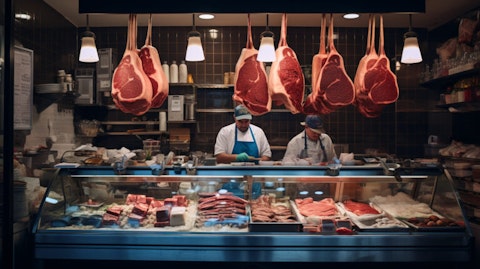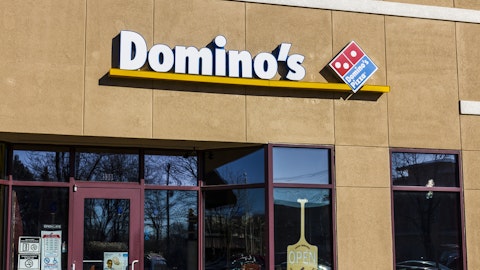The Chefs’ Warehouse, Inc. (NASDAQ:CHEF) Q3 2023 Earnings Call Transcript November 1, 2023
The Chefs’ Warehouse, Inc. reports earnings inline with expectations. Reported EPS is $0.33 EPS, expectations were $0.33.
Operator: Greeting, and welcome to The Chefs’ Warehouse Third Quarter 2023 Earnings Conference Call. As a reminder, this conference is being recorded. I would now like to turn the conference over to your host, Alex Aldous, General Counsel, Corporate Secretary and Chief Government Relations Officer. Please go ahead.
Alex Aldous: Thank you, operator. Good morning, everyone. With me on today’s call are Chris Pappas, Founder, Chairman and CEO; and Jim Leddy, our CFO. By now you should have access to our third quarter 2023 earnings press release. It can also be found at www.chefswarehouse.com under the Investor Relations section. Throughout this conference call, we’ll be presenting non-GAAP financial measures including, among others, historical and estimated EBITDA and adjusted EBITDA as well as both historical and estimated adjusted net income and adjusted earnings per share. These measurements are not calculated in accordance with GAAP and may be calculated differently in similarly titled non-GAAP financial measures used by other companies.

A butcher shop showcasing fresh meats and seafood for customers.
Quantitative reconciliations of our non-GAAP financial measures to their most directly comparable GAAP financial measures appear in today’s press release. Before we begin our remarks, I need to remind everyone that part of our discussion today will include forward-looking statements, including statements regarding our estimated financial performance. Such forward-looking statements are not guarantees of future performance and, therefore, you should not put undue reliance on them. These statements are subject to numerous risks and uncertainties that could cause actual results to differ materially from what we expect. Some of these risks are mentioned in today’s release. Others are discussed in our annual report on Form 10-K and quarterly reports on Form 10-Q, which are available on the SEC website.
Today, we are going to provide a business update and go over our third quarter results in detail. Then we will open up the call for questions. With that, I will turn the call over to Chris Pappas. Chris?
Chris Pappas: Thank you, Alex and thank you all for joining our third quarter 2023 earnings call. Third quarter business activity improved sequentially within the quarter, following a softer than expected July in August, primarily due to the placement of the 4th July holiday observed higher than anticipated overseas travel. Coming out of the summer season, the demand and pricing environment improved as more typical seasonal trends emerged. As we moved into September, we saw a significant sequential improvement and gross profit margins across our markets, and we expect this trend to continue as we move into the fourth quarter and new year. I would like to thank our teams across Chefs’ Warehouse for delivering strong growth and customer acquisition, placement growth, and volume growth during the quarter.
We remain focused on providing our customers with the highest quality products and high-touch service as we continue to grow categories, integrate our recent acquisitions, and drive organic growth across Domestic and International markets. A few highlights from the third quarter as compared to the third quarter of 2022 include; 7. 1% organic growth in net sales. Specialty sales were up 8.2% organically over the prior year, which was driven by unique customer growth of approximately 10.8%, placement growth of 14.2%, and specialty case growth of 9.1%. Organic pounds in center-of-the-plate were approximately 6.6% higher than the prior year third quarter. Gross profit margins decreased approximately 29 basis points. Gross margins in the specialty category decreased 84 basis points as compared to the third quarter of 2022, while gross margins in the center-of-the-plate category decreased 104 basis points year-over-year.
Jim will provide more detail on gross profit margins in a few moments. During our second quarter call, we highlighted the near-term growth related operating cost increases associated with the significant investments we have made infrastructure capacity to facilitate future organic growth as well as the elevated level of acquisitions we have made over the last few years. These expenses relate primarily to operating costs associated with facility expansion, higher acquisition related transition costs, and insurance expense associated with our significant growth over the past 12 months. Our expenses related to our core warehouse distribution and sales operations, excluding these growth related investment costs remain in line with our expectations and historical trends.
We expect the impact of the near-term elevated expenses will lessen as we move into 2024 and 2025. While not a complete list of cost reduction and operational efficiency-related efforts currently underway, I would like to highlight a few of the more impactful projects and work streams aimed at contributing to expected operating leverage in 2024 and 2025. These include our anticipated opening and consolidation of multiple protein processing plants into the Northern California facility we expect to open in the first half of 2024. We expect to consolidate trucks, routes, and operating more efficient operations, utilizing an optimized labor force and technology platform with increased capacity for future growth. We expect to continue to grow our digital capabilities and have recently added our processed protein products to our online ordering platform.
This adds to improving efficiencies in our customer support and sales operations. We expect to reduce acquired growth transition and integration costs going forward, and we expect to begin to see the organic growth leveraging our recently added capacity in Southern California, in Florida, Philadelphia, and other fast-growing regions where we have recently expanded distribution capability. Our overall strategy for growth going forward has not changed. Three primary pillars of our unique growth model, which includes the integration of recently acquired companies, cross-category and cross-platform selling, and driving future operating leverage through the capacity investments we have made as we grow and scale. As we target to average 4% to 6% organic growth over the next two years, we are adapting our capital allocation models as follows.
We expect to gradually reduce capital expenditures to approximately 1% of revenue over the next two years to facilitate higher free cash flow conversion. We are targeting two a half times to three times net debt leverage by year end 2025. And our Board of Directors has authorized a two-year share repurchase program up to $100 million of shares. We are targeting $25 million to $100 million share repurchase by year end 2025. The ultimate total repurchase, if any, will depend on our success in expanding our ability to allocate cash towards repurchase via amendment to our term loan maturing in 2029, which is currently underway, market conditions and free cash flow generation over the timeframe. In terms of acquired growth going forward, we expect to take advantage of potential accretive opportunities that may present themselves within this two-year targeted capital allocation framework.
With that, I’ll turn it over to Jim to discuss more detailed financial information for the quarter and an update on our liquidity. Jim?
Jim Leddy: Thank you, Chris and good morning everyone. I’ll now provide a comparison of our current quarter operating results versus the prior year quarter and provide an update on our balance sheet and liquidity. Our net sales for the quarter ended September 29th, 2023, increased approximately 33.2% to $881.8 million from $661.9 million in the third quarter of 2022. The growth in net sales was the result of an increase in organic sales of approximately 7.1% as well as the contribution of sales from acquisitions, which added approximately 26.1% to sales growth for the quarter. Net inflation was 2.3% in the third quarter consisting of 1.6% inflation in our specialty category and inflation of 3.1% in our center-of-the-plate category versus the prior year quarter.
Gross profit increased 31.6% to $207.7 million for the third quarter of 2023 versus $157.8 million of the third quarter of 2022. Gross profit margins decreased approximately 29 basis points to 23.6%. Gross profit dollar growth in margin during the quarter were primarily impacted by the weaker-than-expected summer season as compared to a strong summer season in 2022. As Chris mentioned, margins improved as we moved through the quarter and our September gross profit margins with a highest month year-to-date in 2023. Selling, general and administrative expenses increased approximately 37.9% to $179.6 million for the third quarter of 2023 from $130.3 million for the third quarter of 2022. The primary drivers of higher expenses were higher depreciation and amortization, primarily driven by acquisitions, and higher compensation and benefit costs, facility and distribution costs associated with higher year-over-year volume growth and the impact of certain acquisitions.
On an adjusted basis, operating expenses increased 34.8% versus the prior year’s third quarter and as a percentage of net sales, adjusted operating expenses were 17.9% for the third quarter of 2023 compared to 17.6% for the third quarter of 2022. Operating income for the third quarter of 2023 was $25.5 million compared to $22.1 million for the third quarter of 2022. The increase in operating income was driven primarily by higher gross profit and lower other operating expense, partially offset by higher selling, general, and administration expenses versus the prior year quarter. Income tax expense was $6.8 million for the third quarter of 2023 compared to $3.1 million expense for the third quarter of 2022. The higher effective tax rate in the third quarter of 2023 was primarily driven by a $2.1 million charge in the current period for return to provision adjustments related to prior year tax returns.
Our GAAP net income was $7.3 million or $0.19 per diluted share for the third quarter of 2023 compared to net income of $8.3 million or $0.21 per diluted share for the third quarter of 2022. On a non-GAAP basis, we had adjusted EBITDA of $50.3 million for the third quarter of 2023 compared to $41 million for the prior year third quarter. Adjusted net income was $13.7 million or $0.33 per diluted share for the third quarter of 2023 compared to $16.4 million or $0.41 per diluted share for the prior year third quarter. Turning to the balance sheet and an update on our liquidity. At the end of the third quarter, we had total liquidity of $182.9 million, comprised of $33.1 million in cash and $149.8 million of availability under our ABL facility.
During the quarter, we prepaid $20 million on our term loan maturing in 2029. The remaining balance as of September 29, 2023 was $277 million and total net debt was approximately $668.1 million, inclusive of all cash and cash equivalents. Turning to our full year guidance for 2023. Based on the current trends in the business, we are providing our full year financial guidance as follows; we estimate that net sales for the full year of 2023 will be in the range of $3.35 billion to $3.425 billion, gross profit to be between $797 million and $812 million, and adjusted EBITDA to be between $188 million and $196 million. Our full year estimated diluted share count is approximately 45.7 million shares. For reporting purposes, we currently expect our senior unsecured convertible notes to be dilutive for the full year and accordingly, those shares that could be issued upon conversion of the notes are included in the fully diluted share count.
Thank you. And at this point, we’ll open it up to questions. Operator?
See also 20 Least Diverse Countries in the World and 25 Jobs That Pay 100k a Month.
Q&A Session
Follow Chefs' Warehouse Inc. (NASDAQ:CHEF)
Follow Chefs' Warehouse Inc. (NASDAQ:CHEF)
Operator: Thank you. We will now be conducting a question-and-answer session. [Operator Instructions] The first question we have is from Alex Slagle of Jefferies. Please go ahead.
Alex Slagle: Thanks. Good morning. Question on the guidance, just curious how much of the EBITDA guide change was from the August dynamics versus the change in the 4Q outlook? It sounds like when we last spoke at the beginning of August, the gross profit trends were under some pressure still from the shifts in seasonality and volatility in certain proteins and continued a little longer, I guess, through August before getting better in September and October. And I guess, was this the source of the reduction in the EBITDA guide?
Chris Pappas: Yes, thanks, Alex, for the question. It was a little bit of both. Definitely the, as you mentioned, and as we mentioned, July and August were weaker than expected. We didn’t get the benefit really of the price inflation as product mix essentially offset that. So we didn’t get the gross profit dollar growth we expected to offset, to generate the expense leverage on expenses. And the second piece is really the impact of our insurance renewals. We are building in Florida, California, and those rates have gone up exponentially. We had our insurance renewals during the third quarter, so we flowed through the elevated growth-related expenses that we talked about in our prepared remarks. So it was about 10 or 12 basis points on the impact of the summer, and then another 10 or 12 basis points on the impact of the elevated growth expenses. That’s basically the adjustment to the guidance.
Alex Slagle: Got it. And with the shift in your capital allocation outlook, it’s now providing room for buyback and more modest leverage targets versus historical levels and perhaps some other options out there with the converts. I mean, how does this impact your longer term view on sales growth, which I think previously incorporated five to 10% growth from M&A and. if there’s any implications on the longer term sales and the views that you provided earlier in the year?
Chris Pappas: Yes, I think, again, I think we’ve always said, Alex, that we’re pretty optimistic. The game has kind of shifted now with rates going so high. We bought a lot over the past 12 months, especially that we’re — we’re taking, I would say, a little pause to better integrate. We have all these new buildings. We have some buildings that were unexpected, that kind of fell in our lap, that were opportunistic. So we have so much right now that unless there was an overwhelming deal that was transformative or something that just made so much sense, there’s always ways to finance those. We thought that a better application of capital right now is to focus more on organic growth, continue to improve our systems, integrate the companies that we have bought, and really drive the bottom line until rates become more attractive again.
Alex Slagle: Makes sense. Thank you.
Chris Pappas: Thanks, Alex.
Operator: The next question we have is from Mark Cullen of UBS. Please go ahead.
Mark Cullen: Good morning. Thanks so much for taking the questions. Why don’t you just start off with inflation, get your take on how the cadence played out, and if there’s any lingering issues with any particular categories this quarter.
Chris Pappas: Thanks for the question, Mark. Inflation has kind of played out throughout the year as we kind of expected, more driven by the base effect. I think we’ve said before, we’ve seen some deflation in certain categories versus the crazy prices you saw last year. But overall, it’s been a story of disinflation as we’ve gone through the year. We’ve gone from 4% or 5% in the first quarter to really 2%, 2.5% this quarter. We kind of expect that trend to continue. Obviously, we have 55,000 products in our warehouses. So there’s — products that are inflation, slightly inflationary, deflationary, but. On an aggregate basis, inflation has really been disinflation this year, but with deflation in certain categories that were obviously overshot last year.
Mark Cullen: Okay. Great. And then just given the current economic backdrop, are you expecting to see more of your growth over the next few quarters take place from expanding penetration of your existing accounts or from adding new business?
Jim Leddy: I think it’s both. I mean, we’ve seen a very healthy pipeline of new business. Restaurateurs open restaurants. That’s what they do, right? So, our really good customers are continuing to open restaurants. So, that drives, the replacement. We average about 7% to 10% of attrition through just natural leases coming up or all sorts of different reasons. So we always need those new openings, but yes, there’s a major focus with the. The businesses that we’ve been developing, we’re in the produce business now, we’re heavily into the protein business. I think the reason that we’re outperforming really the market in our growth, I think we do have industry leading growth, is because the way we do go to the market, that we are cross-selling and introducing all our new categories into markets that we didn’t have those categories.
And I’m pretty confident that’s going to continue and really. That’s our business plan, to continue that cross-selling, continue to grow all the markets that we’ve entered. And eventually we think there’ll be a tailwind, and that’s where we really get that big pop. And that’s kind of our history for almost 40 years.
Mark Cullen: Got it. Thanks so much and good luck guys.
Operator: The next question we have is from Peter Saleh of BTIG. Please go ahead.
Peter Saleh: Great. Thanks for taking the question. I was hoping you give us a little bit of an update on some of the larger acquisitions and the integration of those acquisitions, maybe Greenleaf and Hardee’s that you made earlier this year. Can you just give us an update on where you stand with those acquisitions? And then more specifically with the Chefs’ Middle East, my understanding is when you acquired that brand, it was in need of additional capital for expansion with your updated guidance on CapEx can you just kind of square for how that looks and how much capital you can put into that brand going forward? Thank you.


